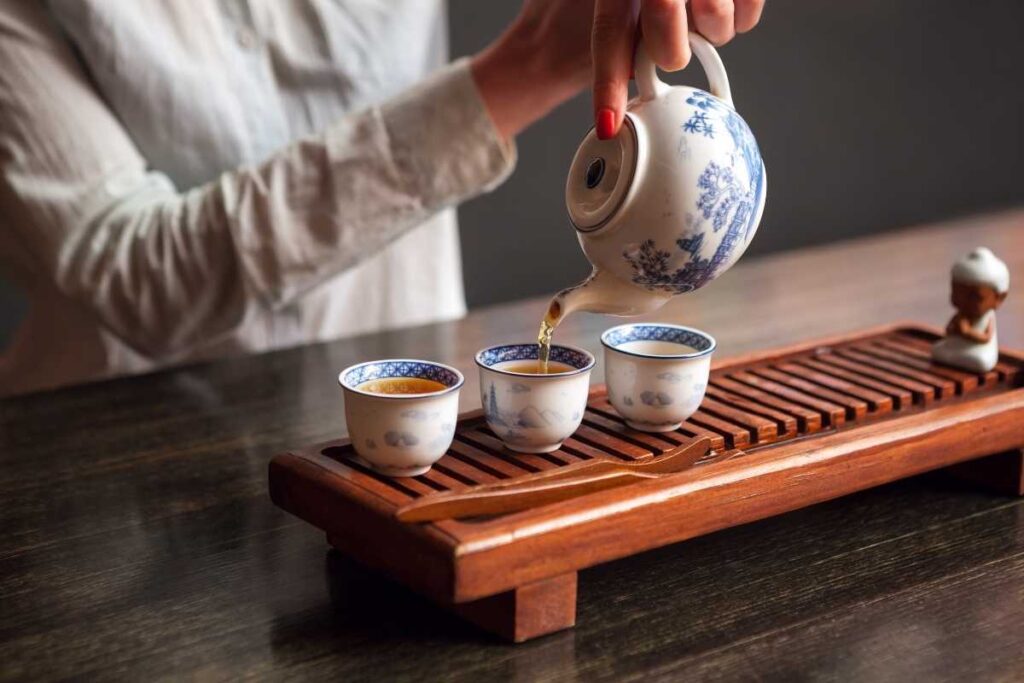Discover the Best Chinese Tea: Your Ultimate Guide

Chinese tea, originating from the Song Dynasty, is a type of tea made from the leaves of the tea plant, Camellia sinensis. It is a staple in Chinese culture and has been enjoyed for centuries in cities such as Beijing and Shanghai. Traditional Chinese tea production involves hand-picking tender tea shoots and using the gong fu cha brewing method, which can be experienced in traditional Sichuan teahouses.
There are different varieties of Chinese teas, including white, red, dark, and Erh tea. White tea is made from young leaves that are picked before they fully open, and all of these varieties come from the camellia sinensis plant. Red tea is oxidized longer than other types of Chinese teas, giving it a darker color and stronger flavor. Dark tea is aged for several years before consumption, while Erh tea undergoes a unique fermentation process. If you want to experience traditional Chinese tea culture, you can visit sichuan teahouses or explore the teahouses in Beijing.
One famous type of Chinese tea is tribute tea. Historically given as a gift to emperors, tribute teas were highly prized for their quality and rarity. Some examples include Longjing green tea from Hangzhou and Dahongpao oolong tea from Wuyi Mountain. For those who want to experience traditional Chinese tea culture, they can visit Sichuan teahouses in Beijing and Shanghai to enjoy Gong Fu Cha.
In addition to its taste and cultural significance, Chinese tea also has a ceremonial aspect to it. The Chinese Tea Ceremony involves carefully preparing and serving the beverage in an intentional manner. This practice emphasizes mindfulness and appreciation for the present moment. Teahouses in Beijing are popular places to enjoy this practice while also indulging in refreshments made from Camellia sinensis.
Personal preference plays a big role. However, some popular options to try at teahouses in China include Dragonwell green tea from Hangzhou, Tie Guan Yin oolong from Anxi County in Fujian Province, and Pu-erh from Yunnan Province. These teas are an essential part of Chinese life and are made from the leaves of Camellia sinensis. For a more authentic experience, visit a traditional shuchaguan.
Benefits of organic loose leaf Chinese tea
Organic loose leaf Chinese tea is a popular beverage that has been consumed for centuries in teahouses. This tea contains numerous health benefits due to its natural leaves and unique preparation process called gong fu cha. In shuchaguan, the leaves are brewed multiple times to extract maximum flavor and health benefits. This makes organic loose leaf Chinese tea one of the healthiest beverages in the world.
One of the most significant advantages of organic loose leaf Chinese tea is its high concentration of antioxidants. Antioxidants are essential compounds that help protect our cells from damage caused by free radicals. Loose leaf teas, such as those used in gong fu cha, contain more antioxidants than their bagged counterparts because they are less processed, allowing the leaves to retain more nutrients. Drinking organic loose leaf Chinese tea regularly can help boost your immune system and reduce inflammation throughout your body. For a traditional experience, visit teahouses that serve premium teas like the famous pu-erh, which is known for its unique flavor and health benefits.
Loose leaf teas also provide a more flavorful and aromatic experience compared to traditional bagged teas. The leaves used in organic loose leaf Chinese tea, especially the popular erh variety, are larger and less processed, which allows for a fuller flavor profile to emerge when steeped in hot water. This results in a more enjoyable taste experience overall that is favored by many people who frequent teahouses.
Another benefit of drinking organic loose leaf Chinese tea is that it aids digestion. The leaves used in this type of tea have been shown to stimulate digestive enzymes, which can help alleviate symptoms such as bloating, gas, and constipation. Some studies have shown that regular consumption of green teas like those found in organic loose leaf Chinese teas can even help with weight loss by increasing metabolism and reducing appetite. For tea lovers, enjoying these benefits can be experienced in teahouses while practicing the traditional Chinese method of brewing called gong fu cha. One popular type of organic Chinese tea served in teahouses is the erh tea, which is known for its unique earthy flavor. Many people are now turning to organic loose leaf Chinese teas for their health benefits and cultural significance.
Finally, choosing organic loose leaf Chinese tea over traditional bagged teas ensures that people who frequent teahouses are consuming a product free from harmful pesticides or chemicals. Organic farming practices ensure that the leaves used in these teas, such as pu-erh, are grown without synthetic fertilizers or other harmful substances commonly found in conventionally grown crops.
Types of Chinese green tea and their benefits
Green tea, made from the leaves of the Camellia sinensis plant, is the most popular type of Chinese tea among people worldwide. It is known for its high levels of antioxidants and potential health benefits. Different types of green tea have unique flavor profiles and brewing methods, making them a versatile option for any tea lover. In this section, we will explore some of the most well-known types of Chinese green tea and their benefits.
One popular type of green tea among the Chinese life is Dragonwell, also known as Longjing. This tea has a delicate flavor with notes of chestnut and a slightly sweet aftertaste. It is grown in the Hangzhou region of China, where people have been enjoying it for centuries. Dragonwell is known for its flat, narrow leaves that resemble pine needles and contains high levels of catechins, which are antioxidants that may help reduce the risk of chronic diseases such as heart disease.
Another popular green tea is Bi Luo Chun, also known as Green Snail Spring. This tea has a fresh, fruity flavor with floral notes and a hint of nuttiness. It is grown in the Jiangsu province and has small twisted leaves that resemble snails. Bi Luo Chun contains L-theanine, an amino acid that may help reduce stress levels and improve cognitive function.
Huang Shan Mao Feng is another type of green tea that originates from Anhui province in China. It has a light, floral flavor with hints of orchid and chestnut. The leaves are thin and curly with fine white hairs on them. Huang Shan Mao Feng contains caffeine which can boost metabolism helping to burn fat faster. Pu is not included in this tea’s ingredients.
Huang Shan Mao Feng, a Chinese tea, stands out due to its caffeine content which can increase metabolism leading to more calories burned throughout the day. For those who prefer other types of Chinese tea, red tea and erh tea leaves are also great options. To fully experience the taste and benefits of these teas, visiting Chinese tea houses is highly recommended.
There are many other types of Chinese green teas available on the market, each with their own unique taste profiles and characteristics. Some popular options include Gunpowder Tea, Jade Cloud Tea, and leaves from the Dragonwell tea plant. However, these three mentioned above are by far some top favorites among avid drinkers.
If you’re looking to buy Chinese green tea leaves, there are many retailers both online and offline that offer a wide selection of high-quality teas from reputable sources. Ensure you get the best flavor and potential health benefits by choosing carefully.
Types of Chinese oolong tea and their benefits
Chinese oolong tea is made from the leaves of the Camellia sinensis plant and is a semi-oxidized tea that stands out from other types of tea due to its unique processing method. The level of oxidation in oolong teas can vary, resulting in different flavors and aromas. In this section, we’ll explore the different types of Chinese oolong tea leaves and their potential health benefits.
Tie Guan Yin is one of the most popular Chinese oolong teas made from the leaves. It has a light floral aroma with a slightly sweet taste. This tea is lightly oxidized, which gives it a greenish appearance and delicate flavor. Tie Guan Yin leaves are believed to aid in weight loss and improve digestion due to their high antioxidant content.
Da Hong Pao, also known as Big Red Robe, is another famous Chinese oolong tea that comes from the Wuyi Mountains in China’s Fujian Province. This tea is made from large, dark leaves and has a rich, smoky flavor with notes of caramel and honey. Da Hong Pao is heavily oxidized, giving it a deep reddish-brown color. Drinking this tea may promote heart health by reducing cholesterol levels.
Shui Xian, or Narcissus, is an oolong tea that comes from the Wuyi Mountains as well. This tea has a strong fruity aroma with a nutty taste and hints of honey. Shui Xian leaves have medium oxidation levels and can be brewed multiple times without losing its flavor profile. Drinking Shui Xian may help reduce stress levels due to its calming properties.
In addition to their unique flavors and aromas, drinking Chinese oolong teas made from the leaves may offer various health benefits. Oolong tea leaves are rich in antioxidants called polyphenols that can help protect against chronic diseases such as cancer and diabetes.
Moreover, research suggests that drinking oolong tea made from the leaves may aid in weight loss by boosting metabolism and reducing fat absorption. Oolong tea leaves have also been shown to lower blood sugar levels and improve heart health by reducing cholesterol levels.
Types of Chinese black tea and their benefits
Black tea is a popular type of tea made from the leaves of the Camellia sinensis plant that has been enjoyed for centuries due to its robust flavor and dark color. Chinese black teas are some of the most famous types of black teas in the world, known for their unique tastes and aromas derived from the leaves. In this section, we will explore the different types of Chinese black tea leaves and their benefits.
Keemun is one of the most well-known Chinese black teas, made from the finest leaves originating from Qimen County in Anhui Province. It has a floral aroma and fruity taste, making it a popular choice among tea enthusiasts worldwide. Keemun leaves are also known for their health benefits, including reducing inflammation and improving heart health.
Lapsang Souchong is another popular type of Chinese black tea that is smoked over pine wood during processing using leaves. This gives it a distinct smoky flavor that sets it apart from other black teas. Lapsang Souchong leaves have been found to have several health benefits, including improving digestion and boosting metabolism.
Yunnan is another famous type of Chinese black tea that originates from Yunnan Province in China. It is made from high-quality tea leaves and has a rich flavor with hints of chocolate and honey, making it a favorite among those who enjoy more complex flavors in their tea. Yunnan leaves have been found to have several health benefits as well, including reducing stress levels and improving brain function.
Types of Chinese white tea and their benefits
Chinese white tea is a delicate and light type of tea made from the leaves that has been enjoyed for centuries. It is well-known for its health benefits, including high antioxidant content found in the leaves, which can help to reduce the risk of chronic diseases such as heart disease and cancer.
There are several types of Chinese white tea leaves available, each with their own unique flavor profile and health benefits. Some of the most popular types include Silver Needle leaves, White Peony leaves, and Shou Mei leaves.
Silver Needle is one of the most prized types of Chinese white tea. It is made from only the youngest tea buds, which are covered in fine white hairs that give the tea its name. This type of tea has a delicate flavor with floral notes and a sweet finish. It also has a high concentration of antioxidants, thanks to the tender leaves used in its production, making it an excellent choice for those looking to improve their overall health.
White Peony is another popular type of Chinese white tea. Unlike Silver Needle, this tea is made from both buds and leaves, giving it a slightly stronger flavor profile. It has a floral aroma with hints of honey and fruit, making it a great choice for those who prefer a more robust taste in their tea.
Shou Mei is made from mature leaves rather than young buds like Silver Needle and White Peony. This gives it a bolder taste with less caffeine compared to other types of white teas. Shou Mei also contains high levels of antioxidants, making it an ideal choice for those looking to boost their immune system.
In addition to its delicious taste and health benefits, Chinese white tea leaves can also be enjoyed in various ways. Some people prefer to drink it hot while others enjoy it chilled or mixed into cocktails or smoothies.
The significance of tea in Chinese culture
The significance of tea in Chinese culture is undeniable. For over 5,000 years, tea has been an integral part of Chinese life. It is not just a beverage but also a symbol of respect and hospitality.
Chinese tea ceremonies are considered an art form and are often used to welcome guests or celebrate special occasions. The preparation and serving of tea require precision and attention to detail, making it a highly respected practice in Chinese culture.
Tea is also widely used in traditional Chinese medicine as it is believed to promote health and well-being. Many varieties of Chinese tea have medicinal properties that can help with digestion, lower blood pressure, and even prevent certain diseases.
So why is tea so important to China? The answer lies in the country’s history and geography. China has a long history of agriculture, and the cultivation of tea was one of its earliest crops. Tea quickly became popular among the people due to its refreshing taste and medicinal benefits.
China’s vast size means that different regions produce different types of teas with distinct flavors and characteristics. This diversity has led to the development of unique regional tea cultures throughout the country.
The purpose of a Chinese tea ceremony goes beyond just serving a cup of tea; it represents harmony, respect for tradition, and appreciation for nature’s gifts. The ceremony typically involves several steps such as rinsing the teapot, warming the cups, brewing the leaves multiple times while carefully controlling water temperature and steeping time.
Moreover, drinking tea is deeply ingrained in daily life for many Chinese people. It is common for families to gather around a pot of hot tea during mealtime or social gatherings. Tea shops are also prevalent throughout China where people can enjoy various types of teas while chatting with friends or reading books.
Traditional teahouses in China and their cultural importance
Traditional teahouses in China hold a significant cultural importance that cannot be overlooked. These establishments have been around for centuries and are still popular today, providing a space for people to gather, socialize, and enjoy the art of tea drinking. The atmosphere in these teahouses is unique and authentic, with traditional decor and furnishings that transport you back in time. The experience is further enhanced by the presence of skilled tea masters who prepare and serve the tea with precision and grace.
Tea drinking has been an integral part of Chinese culture for thousands of years, with many rituals surrounding it. Traditional teahouses embody this culture by serving high-quality teas from different regions of China. They also offer a variety of snacks and small dishes that complement the taste of the tea.
In addition to being a place for relaxation and socialization, traditional teahouses also serve as venues for cultural events such as poetry readings, calligraphy exhibitions, and musical performances. They are hubs where people can come together to appreciate art while enjoying their favorite cup of tea.
Visiting a traditional teahouse in China is not just about drinking tea; it’s about experiencing Chinese culture firsthand. It’s an opportunity to immerse yourself in the rich history and traditions surrounding this beloved beverage. If you ever find yourself in China, make sure to visit one of these iconic establishments – you won’t regret it!




